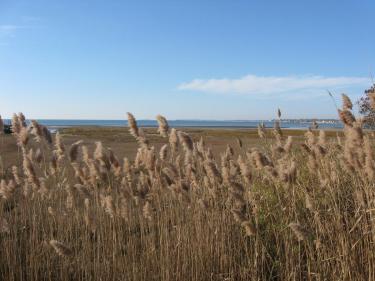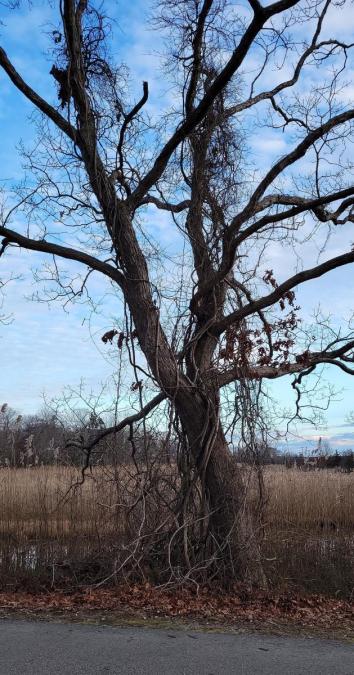Invasive Plants Information
What is an Invasive Plant?
CT General Statues Section 22a-381b defines the characteristics of invasive plants. In Connecticut, plants must demonstrate nine specific criteria to be included on the State's list of invasive and potentially invasive plants. The CT Invasive Plants Council maintains the official CT Invasive Plant List. You can read more about invasive plants in "Invasives" Previously Described and Newly Arrived by the Council on Environmental Quality.

Don't be fooled by this pretty view- phragmites are invasive and destructive!
Why should I remove invasive plants from my property?
Invasive plants are a serious threat to native plants and wildlife. As their name implies, they are uninvited "space invaders" that generally have little to offer local ecology. They provide little or no food value to native wildlife, including native bees and other pollinators. They destroy native food sources and habitat by out-competing native vegetation. Some invasive plants entangle and kill native trees and shrubs. Invasive plants can prevent natural regeneration of native plants. All of this can harm the diversity of species and upset the natural ecological balance. Invasive plants can also harm our waterways by making ponds, lake beds and river bottoms inhospitable to native plant and animal life. Invasive plants do not recognize property lines. They can reestablish on your property by wind-blown seeds, underground rhizomes, and the paws, fur and droppings of wildlife. Invasive plant eradication works best when done on a larger scale (neighborhood-wide), so if you're ready to tackle those invasives, talk to your neighbors!

Tree entangled by oriental bittersweet. Photo: K. Connolly
How can I identify invasive plants?
Many organizations provide information to assist homeowners with invasive plant identification, including UConn's CT Invasive Plants Council (CIPC) and CT Invasive Plant Working Group (CIPWG), the Connecticut Agricultural Experiment Station (CAES), the CT Department of Energy and Environmental Protection (CT DEEP), and the CT River Coastal Conservation District (CRCCD).
These are just some of the information resources available:
CT Invasive Plant List (CIPC)
Field Guide and Plant Management Calendar (CAES)
Invasive Plants in Your Backyard! (CRCCD)
Invasive Aquatic Plants of Connecticut (CAES)
Connecticut's Invasive Aquatic Plant, Clam, and Mussel Identification Guide (CAES)
Mistaken Identity? Invasive Plants and their Native Look-Alikes (USDA)
Giant Hogweed, Heracleum mantegazzianum (CAES)
Top Ten Invasive Plants (CAES)
Local Extension Offices of the UConn College of Agriculture, Health & Natural Resources will accept plant samples for identification and diagnosis, for a nominal fee.
The CT Agricultural Experiment Station also accepts plant and insect samples for identification by mail or in person for no charge.
How can I manage Invasive Plants on my property?
Removing invasive plants from your property can take some time and planning. You can find specific information about removing invasive plants from your property in Connecticut's Invasive Plant Management Calendar (CIPWG) and in the fact sheet links on the Invasive Plant List (CIPWG).
It is valuable to investigate non-herbicidal techniques such as wood chip smothers and strategic cutting. By choosing non-chemical methods, you avoid the potential drawbacks of herbicides. These include potential toxicity to wildlife, aquatic life, pets and children.
Herbicides can be a very effective tool for managing invasive plants, as long as they are used properly according to the product label. Any professional who applies an herbicide or pesticide in CT must be state licensed. You can find a list of licensed applicators on the State's eLicense website under Pesticide Management.
How should I properly dispose of invasive plants?
It is usually best to tackle invasive plants before they have flowered and produced seeds. Once the plants are removed, allow them to dry in a sunny space for at least two weeks. Simply throwing invasive plant parts or seeds into the woods or sending them to the town's brush dump could allow the plants to reestablish wherever the roots, stems or seeds land- they are resilient! Also be aware of this risk in taking compost from the transfer station.
Connecticut statutes govern invasive plant disposal; you can find out about proper disposal methods for specific types of plants in the CIPWG fact sheets Guidelines for Disposal of Terrestrial Invasive Plants and Guidelines for Disposal of Aquatic Invasive Plants.
Why are invasive plants sold by garden centers? Why doesn't the State prohibit them?
There is commercial demand for some of these plants, such as barberry, burning bush, Bradford pear, and privet. A plant can be listed as "invasive" but not banned for sale. The Connecticut Invasive Plants Council monitors the progression of these plants on the landscape to determine whether they meet nine criteria for commercial ban, Until they are banned, they may continue to appear in commercial trade.
What is being done about invasive plants in Town?
The Town's Departments of Public Works and Parks & Recreation have undertaken invasive plant eradication projects at Town Park, Founder's Memorial Park, and The Preserve. The Town has also established a Vegetation Management Fund for the purpose of combating invasive plants within Old Saybrook on public properties.
The Friends of North Cove (with support from the Town and Sustainable CT) is working to eradicate a large area of phragmites in North Cove in order to restore the native salt marsh habitat.
The Old Saybrook Land Trust routinely battles invasive plants on open space properties during their Stewardship Saturdays.
Various groups have participated in invasive plant removal efforts within the 963 acre Preserve property in Old Saybrook, Westbrook and Essex, as is frequently posted on The Preserve Facebook page.
A group of neighbors near Saybrook Point are partnering to remove phragmites and other invasive plants from Town-owned and privately-owned property, and to establish a meadow of native pollinator plants.
Though not in Old Saybrook, there is an active group working to eradicate knotweed in nearby Old Lyme through a regimen of strategic cutting - you can read about their efforts on their Nix the Knotweed Facebook page.
You can view a lively video discussion on the vexing problem of invasive plants by watching the recording of Invasive Plants, Problems, and Solutions featuring local plant expert Kathy Connolly and interviewer Jim Therrien on his show "A Slice of Life" at Valley Shore Community TV, Channel 19, Westbrook CT.
Stay tuned for more information in the coming months as the Town continues to battle invasive plants and restore native landscapes!

